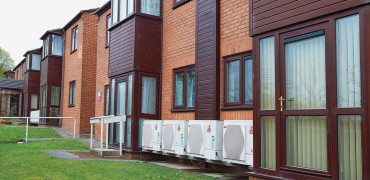Scotland has ambitious plans to reduce its carbon emissions to net zero by 2045.
That’s five years ahead of the UK target date of 2050.
One of the most crucial requirements for meeting that goal is that Scotland eliminates virtually all emissions from heating and cooling in buildings as the report on Scottish Greenhouse Gas Emissions shows.
This means that by 2045, zero emissions heating will have to be employed across Scotland’s building stock – from homes and offices to schools and universities.
It’s no small task and it’s one that requires a big shift in thinking on heating systems in particular.
There are thousands of examples of installations that have been operating for years
The shift to renewables
Like the rest of the UK, Scotland’s goal relies on switching its production of electricity to renewable sources.
The New Build Heat Standard: Scoping Consultation Document sets the goal of reaching 100% renewable electricity production in the early 2020s.
And Scotland has seen a significant change over the past decade.
The Climate Change Committee’s (CCC) Reducing Emissions in Scotland – Progress Report to Parliament 2020 notes that Scotland’s fossil-fuel generation of power has fallen by 70% in the last decade. Use of renewables has tripled in that time.
The drive to Net Zero in Scotland means aiming even further than ‘low carbon’.
In fact, the Scoping Consultation Document states that: “Simply requiring ‘low carbon’ heat will no longer be sufficient – instead it is imperative that new homes consented from 2024 use zero direct emissions and cooling.”
The benefits of heat pumps
The CCC and UK governments currently favour a move to heat pump systems for new homes, with the use of heat networks where feasible.
This is also important in the commercial sector, where heat pumps also provide an effective, low carbon solution for buildings of all types.
The benefit of heat pumps is that they provide low carbon heating, as well as being highly energy efficient: for every 1kW of electricity heat pumps provide around 3kW of heat energy.
Direct electric heating, for example, does not offer that level of efficient heat output.
The Energy Savings Trust responded to the New Build Heat Standard saying that heat pumps as a solution have the benefit of lower running costs, offering a saving for occupants.
But it also pointed to the need to ensure that consumers and building operators are well-informed about heat pump technology and how it operates to ensure they can make the most of it.
Tried and tested
This point is very important and will be key to getting to Net Zero.
Heat pumps are not new technology - at Mitsubishi Electric we have thousands of examples of heat pump installations that have been operating successfully for many years.
But ensuring that owners of those systems (whether that’s in a commercial building or a home) knows what to expect from their heat pump is vital.
I think a lot of this will fall to installers, particularly when it comes to educating householders and busy facility managers.
As a manufacturer, Mitsubishi Electric works hard to ensure that installers are well-trained and able to answer questions, to offer the reassurance that their homes and buildings will be warm and hot water still readily available.
I addressed a few of the common questions about heat pumps in my last blog.
The need for an open mind
Embracing new approaches to heating will not be easy.
It’s fair to say that gas boilers have provided a good service for many decades.
But now our climate emergency means looking at new approaches with an open mind.
Here at Mitsubishi Electric, we want to help provide information and to share our experiences of working with heat pump technology.
So if you’re interested in learning more, feel free to get in touch. Just look me up on LinkedIn.
Erling Binns is M&E Business Development Manager, Scotland



